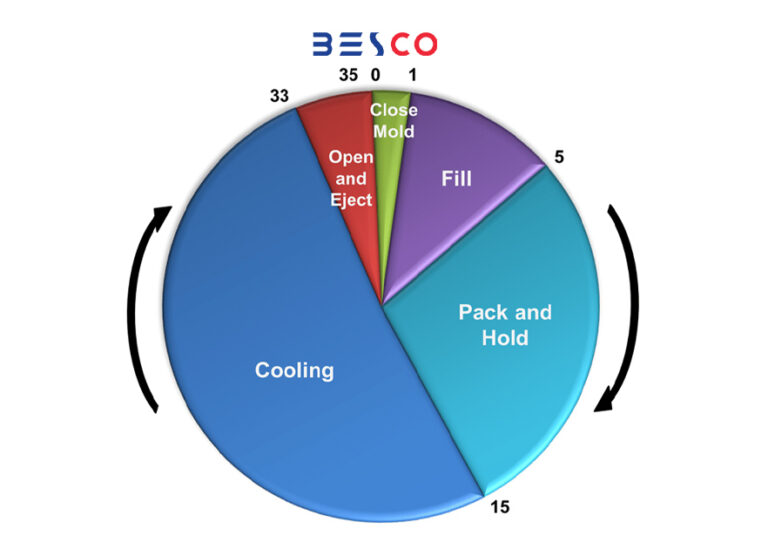Practical Solutions for Optimizing Injection Molding Cycle Time
Optimizing the injection molding cycle time is one of the best ways to improve productivity and reduce costs. The process includes injection, cooling, and product ejection stages, and in the following, we will provide practical solutions for improving each of these stages:

1. Injection Time Reduction
Adjusting Injection Speed and Pressure: The pressure and speed of injection need to be regulated in a way that allows the mold to fill quickly and evenly. The stage can be shortened by applying higher injection speed, but care must be exercised not to sacrifice the product’s surface quality, hence a balance between speed and quality must be met.
Refinement of Injection Screw Size and Diameter: By embracing a screw of the correct diameter relative to part size, injection rate will be increased as well as minimizing cycle time.
2. Reducing Cooling Time
Improving the Efficiency of the Cooling System: The use of advanced chillers in enhancing the cooling system, perfecting cooling channel design, and obtaining the right water or oil temperature can allow cooling time to be saved.
Optimal Designing of the Mold with Cooling Channels: Optimal designing of the cooling channels with maximum contact to the mold surface ensures quick dissipation of heat and thus reduced cooling time.
- Using Materials with Less Cooling Time: Some plastic materials cool faster than others. The employment of such material, wherever possible, saves cycle time.
3. Reducing Mold Opening and Closing Time
- Applying Fast Mold Opening and Closing Systems: Using sophisticated electric or hydraulic opening and closing mold systems optimizes the injection molding cycle time.
- Inspecting and Setting the Ejection Mechanism: Part-ejection mechanisms to eject the part from the mold and align it for the next cycle can reduce product ejection time.
4. Optimizing Mold and Raw Material Temperature
- Mold and Material Temperature Control to a Specific Degree: Temperature control of the mold should be done to minimize cooling time. Properly set mold temperatures will make materials cool and solidify at a quicker rate.
- Raw Material Preheating: Raw material preheating before injection prevents wastage of time in melting them, which minimizes the total injection cycle time.
5. Automation and Robotic Technologies Use
- Application of Robots for Part Ejection: Industrial robots can speed up part ejection operations and reduce overall cycle time.
- Automated Monitoring and Process Control: Smart systems can monitor process data and automatically adjust for maximum cycle time.
6. Reducing Machine Downtime and Maintenance Time
- Preventive Maintenance: Scheduled servicing and maintenance planning will prevent unexpected breakdowns and unwarranted downtime and reduce unwanted cycle time.
- Preparation of Materials and Molds Before Production: To avoid wastage of time in case of material or mold change, all the preparation activities have to be completed before production.
7. Reducing Waste and Errors
- Simulation Software and Correct Settings: Simulations reduce errors and waste, and therefore less time is wasted in correcting errors and machine adjustments.
- Operator Training for Correct Machine Setup: Experienced and trained operators can minimize waste by fine-tuning the settings and avoiding reprocessing.
8. Using Fast-Cooling Materials
- Selecting Suitable Polymers: Some polymers cool faster due to their inherent properties, thus reducing cycle time. For example, thermally conductive materials cool faster, thus optimizing injection cycle time.
9. Reducing Packing Time
- Correct Pressure Hold Time Adjustment: After filling the mold, the pressure hold time must be properly adjusted. The cycle is delayed if the hold time is excessively long. The part will be voided or defective if the hold time is too short.
10. Continual Cycle Time Monitoring and Optimization
- Utilizing Monitoring Data and Periodic Evaluation: Evaluating cycle time data and determining weak points assist in the identification of areas for improvement. With the aid of monitoring software, cycles can be continuously regulated, and parameters tuned so that injection molding cycle time can be further minimized.
Employing these pragmatic solutions, manufacturers can maximize injection molding cycle time effectively, resulting in greater productivity and cost savings.
The Importance of Optimizing Injection Molding Cycle Time
In summary, it is important to maximize injection molding cycle time to improve manufacturing efficiency and reduce the cost of production. By careful analysis and adjustment of various phases of the injection molding process like injection, cooling, and ejection, manufacturers can shorten the cycle without compromising the quality of the product.
The application of sophisticated technologies such as automation, robotics, and simulation software is a key factor in streamlining the whole process and enabling continuous improvement in the reduction of cycle time. Preventive maintenance and ongoing monitoring are also necessary to ensure that an effective and reliable production line is sustained.
Benefits of Optimizing Injection Molding Cycle Time
Lastly, reducing injection molding cycle time is not just a question of reducing the amount of time each cycle takes; it is a question of creating a more sustainable and cost-effective production process. By focusing on continuous improvement in the performance of the injection molding machine, businesses can enhance overall productivity, reduce waste, and maintain high quality levels.
Manufacturers that prioritize optimizing injection molding cycle time and productivity of their injection molding machines will be best positioned to succeed in an increasingly demanding marketplace.
